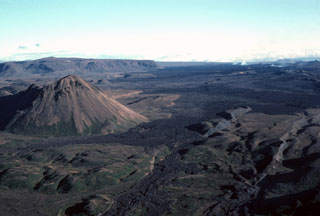Report on Krafla (Iceland) — July 1978
Scientific Event Alert Network Bulletin, vol. 3, no. 7 (July 1978)
Managing Editor: David Squires.
Krafla (Iceland) New deflation 10-13 July; magma intrudes fissures N of the caldera
Please cite this report as:
Global Volcanism Program, 1978. Report on Krafla (Iceland) (Squires, D., ed.). Scientific Event Alert Network Bulletin, 3:7. Smithsonian Institution. https://doi.org/10.5479/si.GVP.SEAN197807-373080
Krafla
Iceland
65.715°N, 16.728°W; summit elev. 800 m
All times are local (unless otherwise noted)
"Krafla deflated again 10-13 July. After the deflation event of 6-21 January, the Krafla area inflated again at the previous rate of about 6-7 mm/day. About 10 June, the inflation slowed down and became somewhat irregular, as had happened shortly before most previous deflation events. Earthquake activity remained low. A new deflation event was anticipated in late June or the following weeks.
"On 10 July at about 1400 slow deflation was recorded at the tiltmeters. The deflation rate increased markedly shortly before 1700 and continuous tremor appeared on seismographs a few minutes later. Maximum deflation rate (11 µrad/hour) and tremor amplitude were reached about 2000. Earthquake activity increased and epicenters migrated northward along the Krafla fault swarm. Maximum earthquake activity occurred early 11 July in the uninhabited area 10-30 km N of Krafla caldera. The largest earthquakes reached magnitude 4.0 and only a few earthquakes were felt.
"The deflation rate decreased gradually during the next two days, and by 2000 on 13 July inflation had resumed. Total subsidence at the center of deflation (Krafla caldera) was about 60 cm. This subsidence is caused by movement of magma from the magma reservoir below the Krafla caldera to a fault swarm to the N. The amount of rifting in the fault swarm remains to be measured but movements on faults of the order of 0.5-1.5 m were observed. No new steam fields were formed but a very substantial increase was observed in the emission of a steam field formed in 1976. The increase occurred in the time interval 0300-0600 on 11 July.
"Inflation now continues at a similar rate as before. Based on previous experience, the next deflation event can be expected in late October or the following weeks."
Geological Summary. The Krafla volcanic system in the Northern Volcanic Zone (NVZ) of Iceland is about 100 km long, consisting of a fissure swarm and a central volcano with a 7 x 9 km caldera formed about 110,000 years ago that deposited a rhyolitic welded tuff. It has been moderately active in the Holocene, over three distinct eruptive periods; the current one has lasted about 2,800 years with six volcano-tectonic episodes, each with one or more basaltic fissure eruptions. Lava volumes (DRE) have been in the 0.1-1 km3 range. The Hverfjall and Ludent tuff rings east of Myvatn were erupted along the fissure system. Myvatn lake formed during the eruption of the older Laxarhraun lava flow from the Ketildyngja shield volcano of the Fremrinamur volcanic system about 3,800 years before present (BP); The present Myvatn lake is constrained by the roughly 2,000 years BP younger Laxarhraun lava flow from the Krafla volcanic system. The abundant pseudocraters that form a prominent part of the Myvatn landscape were created when the younger Laxarhraun lava flow entered the lake. The last eruption took place in 1975-1984 CE when nine small basaltic fissure eruptions produced 0.25 km3 of lava.
Information Contacts: K. Grönvold, NVI; P. Einarsson, Univ. of Iceland.

